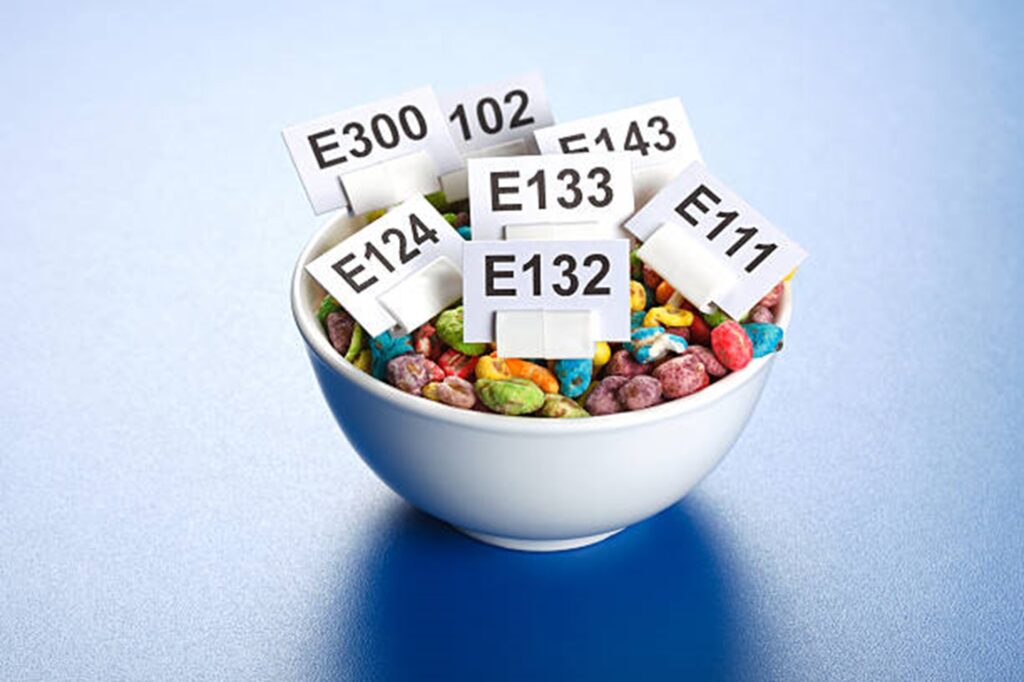E.U. Food Additives Labelling

This post is also available in:
This post is also available in:
![]() Français (French)
Français (French) ![]() Português (Portuguese (Brazil))
Português (Portuguese (Brazil))
A deep delve into those strange names (or numbers) appearing inside the ingredient list of your favorite food
What is an additive?
According to the definition laid out in E.C. Regulation 1333/08, an additive is a substance that is not normally consumed as food, nor is it added to food with the purpose of characterizing it. It is, instead, added to provide a technological function in one or more of the following phases: manufacturing, processing, preparation, treatment, packaging, storage, and transport.
How do I write additives in the ingredient list?
Additives inside the ingredient list of food must always be included by either of the two:
- The class name, followed by the additive-specific name (citric acid, potassium sorbate, etc.)
- The class name, followed by the E number corresponding to the additive (E330, E202, etc.)
A comprehensive list of class names can be found in E.U. Reg. 1169/11 Annex VII part C, or in E.C. Regulation 1333/08 Annex I. Additives must be classified in one of the following categories, according to their function in the final product (when the additive class may not result immediately clear, a short description has been added):
- Sweeteners
- Colors
- Preservatives
- Antioxidants
- Carriers (additives used to physically modify other additives, flavorings, or enzymes to facilitate their use)
- Acids
- Acidity regulators
- Anti-caking agents (additives used to minimize the tendency of substances to adhere to one another)
- Anti-foaming agents
- Bulking agents
- Emulsifier
- Emulsifying salts
- Firming agents (additives used to strengthen a gel or to firm fruit and vegetable tissues)
- Flavor enhancers
- Foaming agents
- Gelling agents
- Glazing agents
- Humectants
- Modified starches
- Packaging gases (gases introduced in a food container to, generally, increase its durability)
- Propellants
- Raising agents
- Sequestrants (additives used to remove metallic ions, forming a bond with them)
- Stabilizers
- Thickeners
- Flour treatment agents
- Contrast enhancers (additives used to impart a distinctive color to fruit and vegetable parts whose original color has been altered in some way)
Set aside some particular cases, each additive has not a single function; therefore, it may be the case that a single additive can be used (and listed in the ingredient list) with different functions.
The additive category to be listed is up to the manufacturer, according to the actual function that the additive undergoes in the final product.
Once decided which category the additive falls into, then it’s time to decide in which one of the two abovementioned ways, the single additive will be listed (either a specific name or E number). Both ways are perfectly compliant with the Regulation, being often just a matter of how much space there is on a label to accommodate the ingredient list (E numbers being considerably shorter than specific names), or a matter of “commercial impact” (E numbers may look a bit intimidating to the average consumer).
The only exception to this rule is if the additive is or derives from an allergen source. The typical case is that of sulfur dioxide or sulfites, which are included in Annex II of E.U. Regulation 1169/11 “substance or products causing allergies or intolerances”.
When these additives are present in the final product in a concentration of 10 mg/Kg (or higher) or 10 mg/L (or higher), then the E number can’t be used to list them; the specific name shall be used instead and shall be treated just like any other allergen, meaning it will be written in a different font if compared to other ingredients.

Is listing additives always mandatory?
No, it’s not! There are some cases in which additives may be omitted from the ingredient list. When an ingredient list is mandatory, additives can be omitted if their presence in the final product is only due to the fact that they were contained in one (or more) ingredients used in the manufacturing of a such product, provided they don’t carry out any technological function in the final product. This is known as the “carry-over principle”, as defined in E.C. Regulation 1333/08.
Needless to say, this does not apply in the case of additives which are allergens, just like said in the previous paragraph. This is something to keep in mind. Allergens must always be listed, with no exceptions whatsoever.
Which additive in which food?
Now consent me to a tiny digression from the “labelling” topic… but I think this is equally useful. First things first, there are a lot of foods in which the presence of an additive is forbidden (not even a carry-over additive). The list is laid out in Annex II Table 1 of E.C. Regulation 1333/08 and includes, among others: unprocessed foods, honey, butter, coffee, pasta, and food for infants and young children.
Moreover, in the same Annex, but in Table 2, a list of food in which colours are not allowed is laid out. These include unprocessed food, milk, bread, pasta, sugar, eggs, and butter.
Once these exceptions are dealt with, it’s time to understand when a certain additive can be added to a particular food. E.C. Regulation 1333/08 provides a rather conspicuous number of tables, each outlining all the restrictions to the use of additives in different food categories.
In those tables, which are positives lists (that is to say, they list all the additives allowed in a given food), the following information can be found:
- Additive E number
- Additive name
- Allowed amount in mg/Kg (quantum satis meaning there is no upper limit, but the quantity of additive needed to provide the desired effect)
- Restrictions of use in specific foods
See the table below as a reference:

Particular cases: sweeteners
Sweeteners represent a rather particular class of additives, following their own set of rules when labelling is implicated. Sweeteners are, in general, used to replace sugars in the production of reduced-energy foods or to increase food durability.
When one or more sweeteners are added as ingredients to a food, the food label must bear the following warning statement: “with sweeteners(s)”. This statement must be included in the name of the food. For food containing both one or more sweeteners and added sugar(s), the following statement must be used instead: “with sugar(s) and sweetener(s)”.
Two sweeteners, finally, have their statement. When aspartame/aspartame-acesulfame salt is added to a food, one of the following statements must be used:
- “Contains aspartame (a source of phenylalanine)”, when the said additive is listed in the ingredient list by its E number
- “Contains a source of phenylalanine”, when the said additive is listed in the ingredient list by its specific name
Particular case: colors
Colors are just another class of additives that has its own set of rules. Colors are used to restore the original color of a food, lost due to manufacturing issues; or they can be used to make the food more appealing; or they can be used to color food that is, by nature, colorless.
Six colors have been found to generate an adverse effect on children; therefore, if they are used in any food the following statement must be added to the label: “E… may have an adverse effect on activity and attention in children”
The six “guilty” additives are:
- Sunset yellow (E110)
- Quinoline yellow (E104)
- Carmoisine (E122)
- Allura red (E129)
- Tartrazine (E102)
- Ponceau 4R (E129)
References
- REGULATION (EC) No 1333/2008 OF THE EUROPEAN PARLIAMENT AND OF THE COUNCIL of 25 October 2011 on food additives
- REGULATION (EU) No 1169/2011 OF THE EUROPEAN PARLIAMENT AND OF THE COUNCIL of 25 October 2011 on the provision of food information to consumers









































































